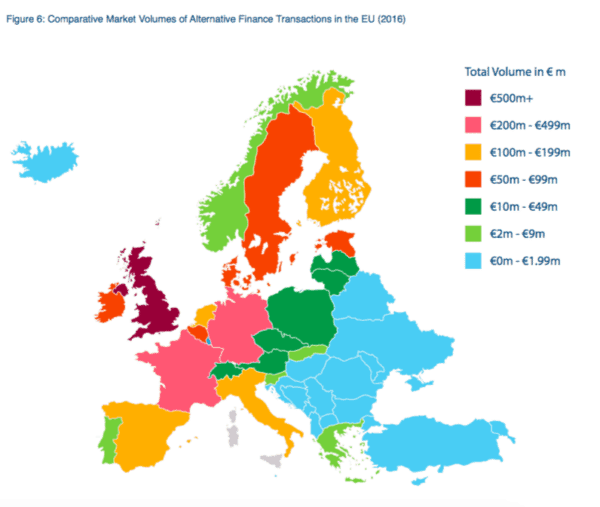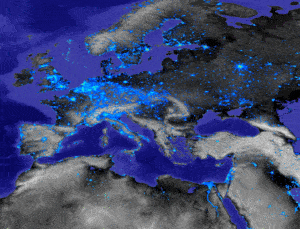
The European online alternative finance market grew by 41 per cent to 7.7 billion euros in 2016, according to the 3rd annual European Alternative Finance Industry Benchmarking Report by the Cambridge Centre for Alternative Finance. The report entitled “Expanding Horizons” indicates that online alternative finance showed growth in new areas across Europe. The report, from the research centre at Cambridge Judge Business School was supported by Spanish-based bank BBVA and the CME Group Foundation, is based on 344 crowdfunding, P2P lending and other alternative finance platforms across 45 European countries.
 “The number of countries in Europe with meaningful alternative finance activity is growing,” noted Robert Wardrop, Director of the Cambridge Centre for Alternative Finance, in a foreword to the report. “The business models and products offered by platforms are evolving and expanding at a rapid pace.”
“The number of countries in Europe with meaningful alternative finance activity is growing,” noted Robert Wardrop, Director of the Cambridge Centre for Alternative Finance, in a foreword to the report. “The business models and products offered by platforms are evolving and expanding at a rapid pace.”
Excluding the United Kingdom, which remained by far the largest alternative finance market in Europe at 5.6 billion euros, online alternative finance grew 101 per cent in Europe to 2.06 billion euros from 1.02 billion euros a year earlier. The UK’s market share in Europe declined to 73 per cent in 2016 from 81 per cent a year earlier as other markets grew faster.
[clickToTweet tweet=”The European online #altfin market grew by 41 per cent to 7.7 billion euros in 2016, according to the 3rd annual European Alternative Finance Industry Benchmarking Report by the @CambridgeAltFin. @bbva #fintech @CMEGroup” quote=”The European online #altfin market grew by 41 per cent to 7.7 billion euros in 2016, according to the 3rd annual European Alternative Finance Industry Benchmarking Report by the @CambridgeAltFin. @bbva #fintech @CMEGroup”]
France (444 million euros), Germany (322 million euros) and the Netherlands (194 million euros) are the three largest European alternative finance markets outside the UK, followed by Finland (142 million euros), Spain (131 million euros), Italy (127 million euros) and Georgia (103 million euros).
 “Financial services are undergoing a profound transformation that will eventually reshape banking completely,” indicated José Manuel González-Páramo, Executive Board Member at BBVA. “We are confident that this study will contribute to the ongoing debate on the evolution of European alternative finance.”
“Financial services are undergoing a profound transformation that will eventually reshape banking completely,” indicated José Manuel González-Páramo, Executive Board Member at BBVA. “We are confident that this study will contribute to the ongoing debate on the evolution of European alternative finance.”
Peer-to-peer consumer lending is the largest alternative finance segment in Europe for the third year in a row, at 34 per cent, followed by peer-to-peer business lending (17 per cent), invoice trading (12 per cent), equity-based crowdfunding (11 per cent) and reward-based crowdfunding (9 per cent).
 “The 3rd Annual European Alternative Finance Report presents the most comprehensive analysis of the status of alternative finance industry in Europe, covering more countries, alternative finance models, as well as industry trends and developments than was available in its predecessors,” stated University of Agder Associate Professor Dr. Rotem Shneor in the report. “Overall, the data collected shows that 2016 saw European alternative finance doubling its volumes from 2015, and continuing an impressive growth. When placed into its short historical perspective, an impression emerges of an industry progressing from an introduction stage catering to innovators, into the growth stage catering to a growing number of early adopters. This growth phase is characterized by entry of new platforms and service providers, overall increasing competition, emergence of rst cases of consolidation, diversi cation of products, and investments in process effectivization and streamlining. Despite exhibiting continuous healthy growth, Europe still punches below its potential.”
“The 3rd Annual European Alternative Finance Report presents the most comprehensive analysis of the status of alternative finance industry in Europe, covering more countries, alternative finance models, as well as industry trends and developments than was available in its predecessors,” stated University of Agder Associate Professor Dr. Rotem Shneor in the report. “Overall, the data collected shows that 2016 saw European alternative finance doubling its volumes from 2015, and continuing an impressive growth. When placed into its short historical perspective, an impression emerges of an industry progressing from an introduction stage catering to innovators, into the growth stage catering to a growing number of early adopters. This growth phase is characterized by entry of new platforms and service providers, overall increasing competition, emergence of rst cases of consolidation, diversi cation of products, and investments in process effectivization and streamlining. Despite exhibiting continuous healthy growth, Europe still punches below its potential.”
Among other findings of the report:
•  Institutionalization grew considerably from 2015 to 2016, with 45 per cent of peer-to-peer consumer lending and 29 per cent of peer-to-peer business lending funded by institutions such as banks, pension funds and asset management firms.
Institutionalization grew considerably from 2015 to 2016, with 45 per cent of peer-to-peer consumer lending and 29 per cent of peer-to-peer business lending funded by institutions such as banks, pension funds and asset management firms.
• Online alternative finance for business continued to grow, providing 1.14 billion euros to more than 14,000 businesses throughout Europe. Debt models including peer-to-peer business lending accounted for 67 per cent of business finance, while equity models accounted for 27 per cent.
• Estonia ranked first for alternative finance volume per capita for the second year in a row, at 63 euros, followed by Monaco (51 euros) and Georgia (28 euros).
• Countries in which platforms believe that existing regulations are adequate are more likely to show higher levels of alternative finance per capita and a larger share of business funding.
• While overall perceptions of regulatory adequacy are divided, the greatest discontent concerns laws governing equity-based crowdfunding
• Two types of risk are of greatest concern to European alternative finance platforms: a potential collapse of a well-known platform due to malpractice, and fraud involving one or more high-profile transactions.
“Last year’s report was entitled ‘Sustaining Momentum’,” explained the Cambridge Centre for Alternative Finance in its report. “Findings for 2016 provide evidence that alternative finance in Europe has certainly sustained momentum. As such, this report is titled ‘Expanding Horizons’ to reflect the positive developments in Europe in alternative finance in 2016, and sets a stage for further and future development of the industry.”
______________________________________________________

